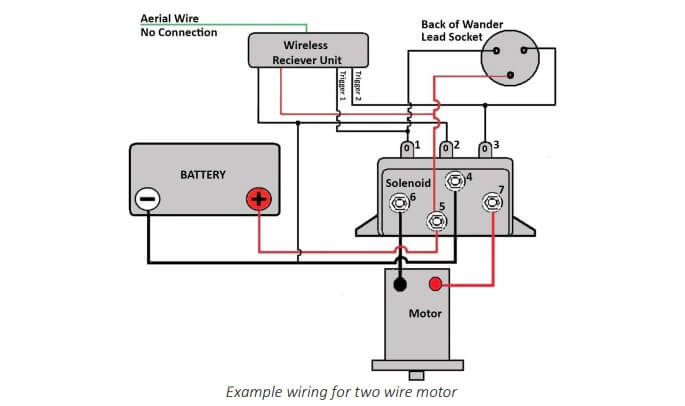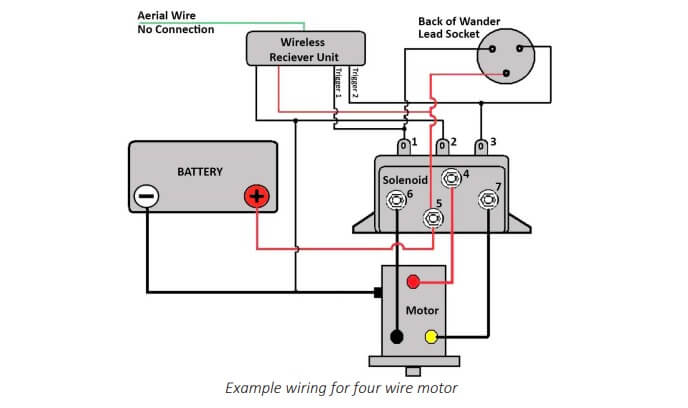To wire a winch solenoid, first disconnect the battery. Mount the solenoid near the battery or winch. Connect the power cables from the battery to the solenoid’s large terminals, then link the winch motor to the solenoid’s opposite terminals. Use the provided color-coded wires to connect the winch control switch. Reconnect the battery and test the system. This guide provides detailed wiring diagrams, common mistakes to avoid, and troubleshooting tips.
In this guide, you’ll learn how to wire a winch solenoid, including the tools, wiring diagrams, and troubleshooting tips you need.
Quick Answer
How to Wire a Winch Solenoid (Quick Guide):
- Prepare Wires and Connectors: Strip and crimp the wires to ensure secure connections.
- Connect Battery to Solenoid: Attach the positive battery cable to the solenoid’s input terminal.
- Ground the Solenoid: Secure the ground wire to a clean metal surface on the vehicle chassis.
- Wire Control Cables: Connect the control switch or remote to the solenoid’s control terminals.
- Connect Solenoid to Winch Motor: Attach the output wire from the solenoid to the winch motor’s positive terminal.
Tools and Materials Needed
Before we start, make sure you have the following tools and materials:
Tools:
- Welding equipment (MIG or TIG welder, welding gloves, and mask)
- Angle grinder or cutting torch
- Wrenches and sockets
- Drill and drill bits
- Clamps
- Measuring tape
- Marker or soap stone
Materials:
- Steel tubing (typically 2-3 inches in diameter, thickness depending on weight capacity needs)
- Steel plate for winch mounting
- D-rings or recovery points
- Hardware (nuts, bolts, washers)
- Optional: Lights, skid plates, or other accessories
Safety Gear:
- Welding helmet or face shield
- Fire-resistant clothing
- Gloves
- Safety glasses
Also check: Best Winch Solenoid
How to Wire a Winch Solenoid: Step-by-Step Wiring Instructions


Step 1: Prepare the Wires and Connectors
First, you need to prepare the wires and connectors.
Start by cutting the wires to the appropriate lengths.
Make sure they can reach from the battery to the solenoid and from the solenoid to the winch motor without being too tight or too loose.
Next, strip the insulation off the ends of each wire using wire strippers.
You want to expose about an inch of the bare wire.
Be careful not to nick the wire strands, as this can weaken the connection.
Now, it’s time to attach the connectors. Slide the connectors over the bare ends of the wires and use crimpers to secure them in place.
Make sure the connectors are tightly crimped so they won’t come loose. A good connection is essential for preventing electrical issues down the line.
Make sure your wires are rated for your winch’s capacity so they can handle the electrical load effectively. This prevents issues such as overheating or voltage drops during operation.
Step 2: Connect the Battery Cable to the Solenoid
With your wires and connectors prepared, you can start connecting them to the solenoid.
Begin with the battery cable. This is a thick power wire that carries electricity from the battery to the solenoid. Attach one end of the power wire to the positive terminal of the battery. Use a wrench to tighten the terminal nut securely, but avoid overtightening, as it could damage the battery post.
Next, connect the other end of the power wire to the appropriate terminal on the solenoid. This terminal is usually marked with a “+” sign or labeled as the power input. Again, ensure the connection is tight and secure.
The battery cable is crucial because it powers both the solenoid and winch motor. Be sure to follow the wiring diagram specific to your winch model for accurate connections.
Step 3: Connect the Ground Cable to the Solenoid and Vehicle Chassis
The next step is to connect the ground cable. This wire completes the electrical circuit by connecting the solenoid to the vehicle’s chassis.
Start by attaching one end of the ground wire to the solenoid’s ground terminal.
This terminal is usually marked with a “-” sign or labeled as the ground.
Then, connect the other end of the ground wire to a clean, bare metal spot on the vehicle chassis.
You might need to use a wrench to remove any paint or corrosion from the connection point to ensure a good ground connection. Tighten the connection securely.
The ground connection completes the electrical circuit. Ensure a solid connection to the vehicle chassis for uninterrupted operation. Use a multimeter to verify electrical continuity after connecting.
Step 4: Wire the Control Cables (Switch or Remote)
Now it’s time to wire the control cables. These smaller wires connect the solenoid to the switch or remote control that you use to operate the winch.
Connect the control wires from the switch or remote control to the solenoid’s control terminals. These terminals are often color-coded to match the wires, making it easier to connect them correctly.
Ensure each wire is attached to the right terminal, as specified in your winch’s wiring diagram.
The control cables transmit signals from the remote or switch to the solenoid. Proper installation ensures precise control over the winch’s in and out functions.
Step 5: Connect the Solenoid to the Winch Motor
Finally, you need to connect the solenoid to the winch motor. This involves attaching a power wire from the solenoid to the winch motor’s positive terminal.
Start by connecting one end of the power wire to the appropriate terminal on the solenoid. This terminal is typically labeled for the winch motor output.
Then, connect the other end of the power wire to the positive terminal on the winch motor. Make sure this connection is tight and secure to ensure reliable operation.
Always refer to the manufacturer’s manual to identify the correct motor terminal (positive or negative). Miswiring can damage the motor or reduce performance.
Safety Precautions
Safety first! Here are some crucial safety tips to follow:
- Disconnect the battery before starting any wiring work to prevent accidental shocks or short circuits.
- Ensure cables are routed away from sharp edges, heat sources, and moving parts to avoid damage.
- Use electrical tape to insulate all connections and prevent short circuits.
- Use zip ties or clamps to organize the cables, preventing them from touching sharp edges or hot components. This improves safety and durability.
Troubleshooting Tips
Even with careful installation, issues can arise with your winch solenoid wiring. Here are some common problems you might encounter and their solutions:
Winch Not Working
If your winch is not working at all, here are a few steps to troubleshoot the issue:
- Check All Connections:
- Ensure all the electrical connections are tight and secure. Loose connections can prevent the necessary current from reaching the winch motor.
- Inspect each connection point from the battery, solenoid, ground, and winch motor. Make sure the terminals are clean and free from corrosion.
- Battery Charge:
- Verify that your battery is fully charged. A weak or dead battery will not provide enough power for the winch to operate.
- Use a multimeter to check the battery voltage. A fully charged battery should read around 12.6 to 12.8 volts. If it’s lower, consider recharging or replacing the battery.
- Inspect the Fuses:
- Check the fuse in the winch circuit. A blown fuse can interrupt the power supply. Replace any blown fuses with the correct type and rating.
- Check the Solenoid:
- Test the solenoid to ensure it’s functioning properly. You can do this by listening for a clicking sound when you activate the winch. If there’s no click, the solenoid might be faulty.
Intermittent Operation
If your winch operates sporadically or intermittently, here’s what to check:
- Inspect Control Wires:
- Look for any signs of damage on the control wires, such as fraying, cuts, or burns. Damaged wires can cause intermittent connections.
- Ensure the control wires are securely connected to both the switch or remote and the solenoid. Loose connections can lead to inconsistent operation.
- Check for Corrosion:
- Corrosion on the terminals or connectors can disrupt the electrical flow. Clean any corrosion with a wire brush and apply dielectric grease to prevent future corrosion.
- Examine the Switch or Remote:
- Test the switch or remote control for faults. If the switch is not making proper contact, it can cause intermittent operation. Replace the switch if it’s faulty.
Solenoid Clicking but Winch Not Running
If you hear the solenoid clicking but the winch motor doesn’t run, consider these steps:
- Check the Battery:
- Even if the battery is providing some power, it might not be enough to turn the winch motor. Test the battery voltage under load (while trying to operate the winch). If the voltage drops significantly, the battery might be weak and need replacing.
- Inspect the Solenoid:
- A clicking solenoid indicates it’s receiving a signal from the switch, but it doesn’t necessarily mean it’s allowing power through to the winch motor. Test the solenoid with a multimeter to ensure it’s working correctly. If the solenoid is faulty, replace it.
- Check the Motor Connections:
- Ensure the power cable from the solenoid to the winch motor is securely connected. A loose connection can prevent the motor from receiving sufficient power.
- Test the Winch Motor:
- Connect the winch motor directly to a power source to see if it runs. If it doesn’t operate when directly powered, the issue likely lies within the motor itself, and it may need servicing or replacement.
Maintenance and Care
To keep your winch solenoid in top shape, regular maintenance is key:
- Inspect Connections: Periodically check all wiring connections for corrosion or looseness.
- Clean Terminals: Clean battery and solenoid terminals to ensure good electrical contact.
- Protect Wiring: Use zip ties and protective covers to keep wires secure and shielded from the elements.
Also check: how to wire a winch without a solenoid
FAQs
Is it possible to wire a winch without a solenoid?
Yes, by directly connecting the battery to the winch motor using a manual switch. However, this setup lacks the safety and control features provided by a solenoid.
What are the steps to troubleshoot a faulty solenoid?
Check for loose connections, test the solenoid with a multimeter, and inspect for corrosion or damage.
What is the purpose of a winch solenoid?
A winch solenoid acts as a switch that safely and efficiently controls the electrical current flowing from the battery to the winch motor, allowing smooth operation and preventing electrical overloads.
How can you tell if a winch solenoid is failing?
Signs of a bad solenoid include the winch not operating, intermittent operation, or hearing a clicking sound without the motor running. Use a multimeter to test for continuity across the solenoid terminals.
Can a winch solenoid be repaired?
Some solenoids can be repaired by cleaning or replacing corroded or damaged terminals. However, if the internal components are damaged, replacing the solenoid is usually more reliable.
Why is grounding the solenoid important?
Grounding ensures the completion of the electrical circuit, enabling proper operation of the solenoid and winch. A poor ground connection can result in erratic or no functionality.
Conclusion
In summary, wiring a winch solenoid may seem daunting, but with the right tools, materials, and instructions, you can do it successfully.
Follow these steps carefully, prioritize safety, and you’ll have a reliable winch system ready to tackle any heavy lifting. Happy winching!

